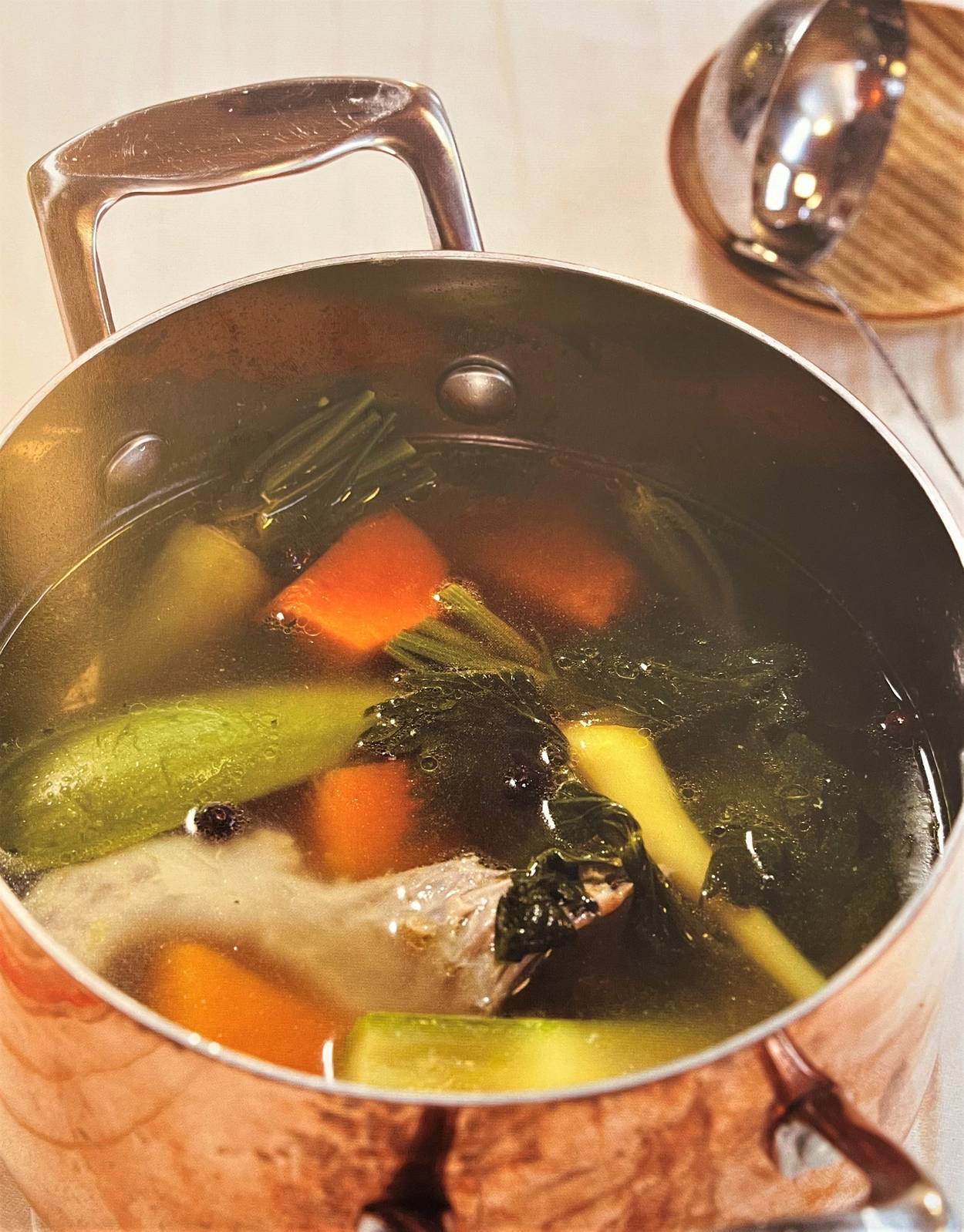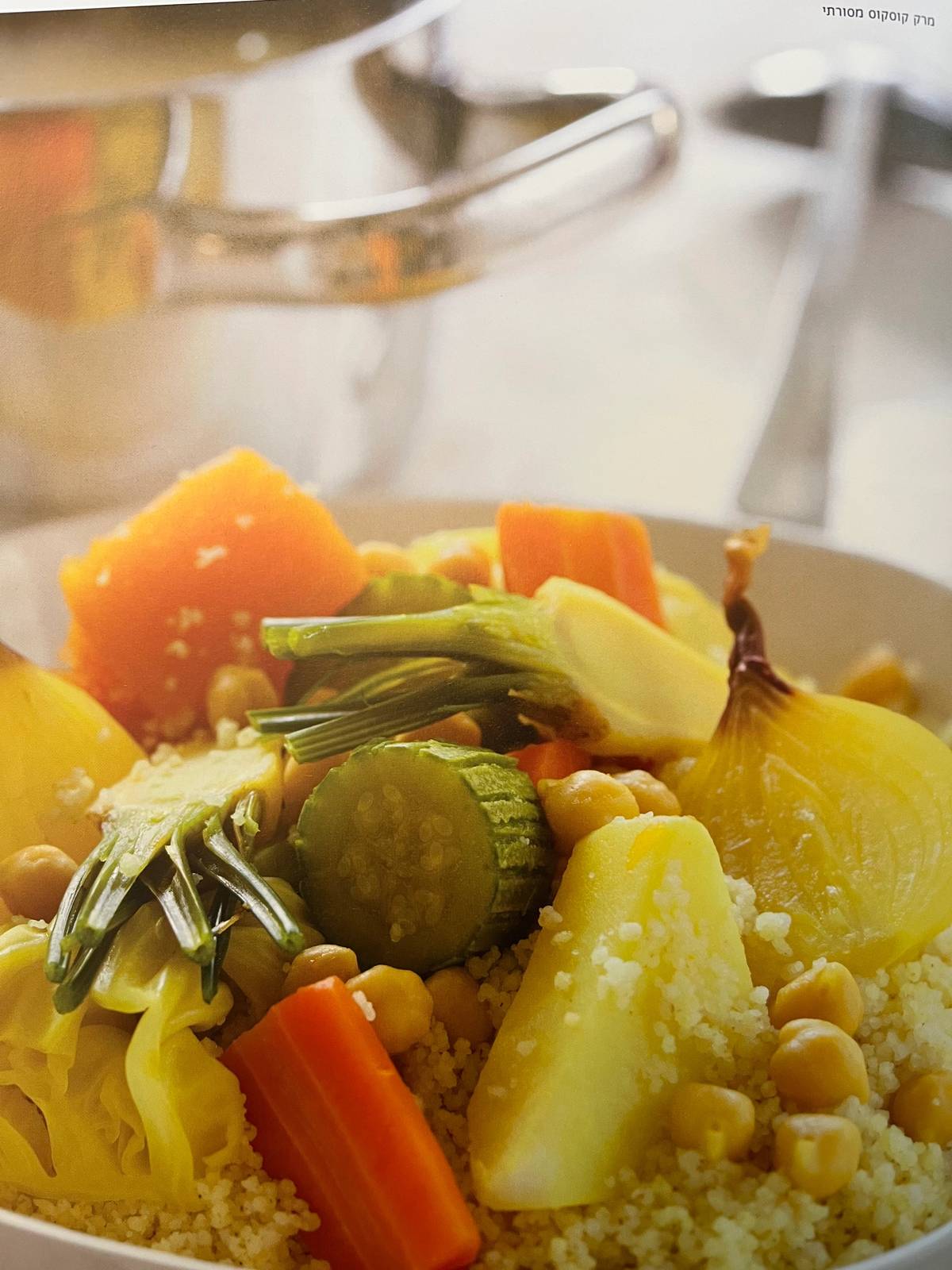Chicken Soup, Israeli-Style
The Ashkenazi staple has been adapted, merging with ethnic versions from everywhere from Minsk to Marrakesh, to become a uniquely Israeli fusion




In fall 2008, my first book dedicated to Israeli food was published in the U.S. Like all first-time authors, I anxiously and rather obsessively scouted the web for write-ups about my newborn. Thankfully, most reviews were positive, some raves, but there were also a couple of mixed ones, which I completely blew out of proportion. One such review actually called my new book “lovely” but warned that the author shouldn’t be trusted when it comes to Ashkenazi food. A case in point: chicken soup.
Here is an excerpt:
A classic Jewish chicken soup is simple: a chicken, carrot, onion, a little bit of celery (too much and it takes over). Put everything in a pot with water to cover. Simmer on stove gently three to five hours, depending on your chicken. When it’s done, you can slice the meat from the bones and put it back in the soup. … Gur’s recipe, which she calls classic and places in the Shabbat (Sabbath) section, calls for parsley, dill, and celery leaves. Coriander (!), thyme, and rosemary are optional. She suggests adding beef cuts like breasts or ribs to the soup for a “meatier” taste. As for vegetables: The more the better: onions, leeks, carrots, celery root, parsley root, pumpkin, courgettes (summer squash), tomatoes and even fennel. … No. No, no, no … do not ever, ever put pumpkin (or fennel, or coriander, or celery root) into your soup and call it Jewish. My grandmother will rise from the grave, and woe unto you.
I was more surprised than offended. Chicken soup is my forte. Granted, the recipe wasn’t passed down to me by my bubbe—both my grandmothers had died before I got into cooking—but as the editor of an Israeli food magazine, I learned from the best. So what was I missing? Are pumpkin, celery root, and zucchini so unorthodox? Is adding meat other than chicken such a travesty?
I looked up other chicken soup recipes published in Israeli cookbooks, magazines, and websites. Although there were many variations, practically all of them called for plenty of vegetables: Carrots, onions, parsley, celery root, and zucchini popped up in every recipe; many also featured pumpkin, cabbage, and even fennel. A few went so far as adding potatoes or sweet potatoes (this is where I draw the line). The seasoning ranged from the standard salt and black pepper, to cumin, turmeric, allspice, and white pepper. At this point I was actually thankful for the reviewer for affording me an important insight, one that I should have arrived at by myself: Chicken soup that we cook in Israel is a product of fusion. What kind of fusion? Before we get into that, a few words about the status of chicken soup on the Israeli food scene.
If you have visited Israel or even eaten in an Israeli restaurant anywhere in the world, you surely know that the local food scene is predominantly Mediterranean and Middle Eastern, heavily influenced by Palestinian cooking and Jewish immigrant cuisines from the regions close to us geographically: North Africa, the Balkans, Yemen, Iraq, and Iran. Ashkenazi cooking is much less pervasive, and often regarded as boring and bland. But there are a few notable exceptions, and interestingly all are associated with Shabbat. Challah (homemade or store-bought) has become the standard Shabbat bread, so much so that most Israelis aren’t even aware of its Ashkenazi roots. Another example is cholent. This iconic Shabbat casserole may have been devised to keep one warm and satisfied on a chilly night in Ukraine or White Russia, but you should see Israelis queueing up for a bowl of the heavy stew at a Shabbat brunch buffet in Israeli hotels, even when the temperatures outside climb to 95 degrees.
As for chicken soup, it is simply everywhere. From kibbutz dining halls to military canteens to hotel dining rooms and private homes, chicken soup is a mandatory part of the Friday night menu in Israel. It is usually served with vermicelli or shkedey marak, the commercial version of soup mandel—salty and heavy on artificial coloring, they are a big hit with kids from 8 to 80. In most Israeli households, regardless of their provenance, chicken soup with kneidlach will reappear on the Seder table. Once at a multiethnic Passover meal, I witnessed one of the guests (I believe he was from a Yemenite family) adding a spoonful of Ashkenazi chrain (red horseradish) to his chicken soup. “You need to put some life into this bland thing,” explained the man as he was gulping down the vividly violet liquid.
Chicken soups are popular in quite a few Jewish cuisines. There is Persian gondi soup, served with exotically perfumed dumplings made from ground chicken and chickpea flour. There is Yemenite chicken soup, which is similar in spirit to the Ashkenazi one, in that it has very few veggies, but these veggies are potatoes and onions, rather than parsley and dill there is a bunch of cilantro, and of course it is redolent with hawayij, the famous Yemenite spice mix. In Romanian chorba, the end result is very different from the classic chicken soup because there is an addition of vinegar and meatballs, but the vegetable combo (onions, carrots, cabbage, leeks, cabbage, tomatoes, and lots and lots of parsley, dill, and celery) is very similar.

But of all ethnic Jewish chicken soups, the one that most closely resembles the Israeli version is Moroccan couscous soup. Pumpkin, leeks, cabbage, celery root, zucchini, and carrots are all there. The main difference is the addition of chickpeas and a pinch of either saffron or turmeric. Just as the classic Jewish chicken soup is not worth its reputation without some manner of carbs (lokshen, kneidalach, kreplach, or soup mandel), so Moroccan chicken soup is first and foremost a foil for hand-rolled couscous, the pride and joy of North African gastronomy. The proper way to serve the dish is to put a few heaping tablespoons of couscous in a deep plate, arrange some cooked vegetables on top, and ladle a bit of liquid—not too much lest the couscous grains get soggy. In the Ashkenazi version, the hierarchy is reverse: The fragrant golden liquid is the star, with noodles or dumplings adding substance and texture.
Moroccan cuisine was one of the first ethnic Jewish cuisines to affect mainstream Israeli cooking. The Jewish Moroccan community is one of the largest in the country, and many Moroccan Jews went to work in the food-service and hospitality business, and exposed other cooks and the public to their cuisine. I remember an article about Israeli food published in the 1990s by my friend Rozanne Gold, who was one of the first food experts to note that something fascinating was happening on the Israeli culinary scene. She described our evolving cuisine as a combination of Jewish and Arabic food traditions with a distinct North African slant. And right she was. It is perfectly plausible that a hotel cook of Moroccan provenance added a wider selection of veggies to the chicken soup pot, or that an Ashkenazi homemaker adopted elements from the couscous soup her Moroccan neighbor used to cook. This is exactly the kind of culinary cross-fertilization (which is a fancy way to describe recipe swapping) that gave birth to many local classics, including what evolved as the Israeli chicken soup. And yes, it is different from the Ashkenazi original, its flavor a cross between the traditional goldene yoich and clear, fragrant vegetable broth.
In 2014, I published my second book, Jewish Soul Food—From Minsk to Marrakesh. Dedicated to Jewish cooking around the globe, it featured a recipe for the soup that was very similar to the one I included in my first book, only this time I learned my lesson and called it “Israeli.” You will find the recipe below, but first, a short guide to chicken soup the Israeli way.
Meat: Some cooks use whole birds, which makes sense if you like boiled chicken meat, but cheaper parts like wings and necks will give even more flavor at a fraction of the price. To deepen the flavor even more, try adding a couple of beef knee bones or (my favorite) a turkey neck. There is a theory that kosher chickens are bigger, juicier, and tastier than treyf. Since Israeli butchers and supermarkets only sell kosher chickens, I have a very limited experience with nonkosher ones, but I did notice that their texture was drier and I needed to add more salt.
Vegetables: The heart and soul of Israeli chicken soup. My favorite set includes onions, leeks, carrots, celery root, parsley root, celery ribs, pumpkin, zucchini (courgettes), fennel, and a whole tomato. The latter makes the color deeper and adds a barely there hint of tartness that flatters other flavors.
Herbs: Parsley, dill, and celery leaves are a must, but try adding a bit of cilantro and/or thyme. Delicious! Whatever the choice, be generous with the amounts and try the double-bunch trick: Divide the herbs in half and line the bottom of the pot with one half before adding the rest of the ingredients (this will spread the aroma evenly and prevent the herbs from floating up to the surface). Tie the second half with kitchen twine and add to the soup when it is almost ready for a boost of fresh, herby aroma.
Seasoning: Salt and whole peppercorns are mandatory. Allspice, bay leaves, and white pepper are optional but worth trying. As for the avkat marak (powdered chicken soup mix, the secret weapon of the Israeli home cooks) I admit that sometimes I add a spoonful (after making sure it is MSG-free), but please don’t tell anybody! In any case, it is important to wait for the meat and the vegetables to release their flavors into the liquid before adding salt, especially when you cook a kosher chicken.
Method: Some cooks boil the chicken first, skim the foam, and only then add other ingredients. This will result in a clearer broth. I prefer putting all the ingredients in cold water and heating everything together, to ensure maximum extraction of flavors. If you plan to serve the cooked chicken parts, remove them from the pot while they retain their texture and succulence.
Straining and storing: Move the pot to the fridge as soon as possible to prolong its shelf life. Wait for the soup to cool before straining it—vegetables in the hot soup are very soft and might fall apart. They become a bit firmer when cooled. Once the soup is completely chilled, there will probably be a layer of fat on top—skim it with a spoon. You may want to keep that fat in a jar for use in other dishes. As with all soups, the flavor gets better and stronger after a day or two.
Many thanks to my friends and collaborators who shared with me their chicken soup wisdom: Chef and culinary consultant Avi Steinitz and cookbook author Orly Pely-Bronshtein.
Janna Gur is a Tel Aviv-based writer and journalist. She is the author of The Book of New Israeli Food, Jewish Soul Food from Minsk and Marrakesh, and Shuk (with Einat Admony).